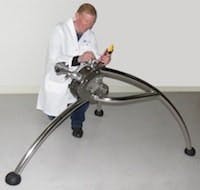Large underground water storage tanks are a common feature of many water distribution systems in the United States and Europe. These basins are typically rectangular, shallow and concrete and feature numerous columns that support a thick roof. Unlike aboveground storage tanks, which are often visible for miles, underground storage tanks are hidden from view. In many cases, municipalities utilize the land above the storage reservoir for recreation or parking.
While underground tanks may have some aesthetic advantages, they face significant disadvantages when it comes to water quality. The shape of underground reservoirs is typically chosen to minimize construction costs and accommodate features of the construction site—not to preserve finished water quality. Even if they are constructed with a separate inlet and outlet, the geometry of many underground reservoirs promotes short-circuiting and poor mixing. Also, the “out-of sight, out-of-mind” nature of these reservoirs means that regular inspection and cleaning can be a low priority.
A number of large underground reservoirs have been designed, or retrofitted, with passive mixing systems, but the track record for these systems is mixed. Because passive systems only provide mixing during the fill cycle, they require significant turnover in order to be effective. Once the fill cycle ends, mixing stops. A final disadvantage lies in chemical dosing: without a constant source of mixing energy, disinfectant added to an underground tank will fall to the bottom of the tank and not mix effectively. As a result, more municipalities are removing these systems in favor of active mixing systems.
Active mixing systems can significantly improve hydraulics inside large underground tanks. Unlike passive mixers, active mixers operate 24 hours a day, 7 days a week, 365 days a year, providing a constant source of velocity. More importantly, some active mixers can be designed to orient flow in any direction, providing lateral as well as vertical mixing. Finally, active mixers hold a key advantage over passive systems: they enable the safe and effective dosing of water inside underground tanks.
Two Municipalities, Two Mixing Success Stories
Ontario, Calif., operates a 2.75 million gal rectangular, in-ground, concrete tank that has suffered from poor water quality. Even though the tank was below grade, warm weather caused significant thermal stratification with temperature differences as high as 16°F from top to bottom, which resulted in poor circulation, low turnover and high water age. PAX Water ran a detailed Computational Fluid Dynamics (CFD) model of the reservoir to ensure that the system would adequately mix the tank. CFD is a powerful tool for revealing the flow dynamics in a system (such as an underground water tank) where direct velocity measurements are difficult. The CFD model showed that despite the presence of numerous columns, the flow pattern created by the PAX Water Mixer circulated the entire contents of the reservoir—even out to the far ends of the basin. After installation of the PAX Water Mixer, the stratification was reduced from almost 16°F to less than 1°F and total chlorine residual measured at the exit of the tank rose from 0.5 ppm to 0.65 ppm in less than 48 hours.
The city of Phoenix manages several large underground reservoirs, the largest of which is 547 ft long and 412 ft wide, capable of holding 30 million gal. Operators were concerned that changes in their inlet and outlet configurations would create large dead zone in this reservoir. The PAX Water staff conducted a CFD study that confirmed the potential for this large dead zone and used the CFD to design an optimal circulation pattern inside this reservoir using several PAX Mixers—three of which that would push water horizontally in the tank, while the fourth would circulate the water vertically. In addition to eliminating zones of high water age, the mixers include an integrated chemical feed system to allow for the safe and reliable dosing of water in this large storage tank.
Municipalities face tougher water quality standards, and increasing consumer demands for stable, good-tasting drinking water. Active mixing, as well as regular tank cleaning and maintenance, can help stabilize and improve water quality. Combining chemical dosing and water quality monitoring with active mixing can enable municipalities to control water quality conditions in their underground tanks year-round.
Peter S. Fiske is the CEO of PAX Water Technologies. Fiske can be reached at 866.729.6493 or [email protected].



